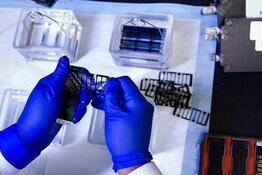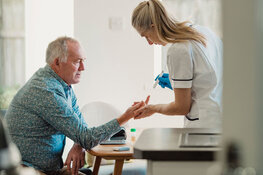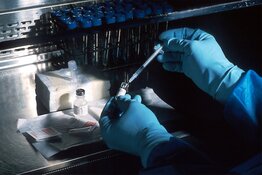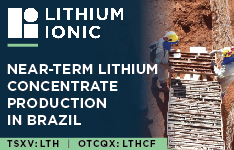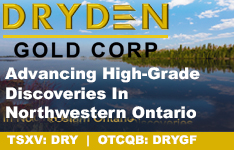The Life Sciences Report: Debjit, you're a biomedical engineer by training, and did your post-doctoral fellowship at Memorial Sloan Kettering Cancer Center. You have authored more than 20 peer-reviewed papers, and you have two patents. Is there anything I've missed?
Debjit Chattopadhyay: My background is in drug delivery and medical devices, and subsequently, at Sloan Kettering, I was with the translational medicine group, primarily focusing on radioimmunotherapy and antibody-drug conjugates.
TLSR: And today you're a sellside analyst, working with institutional investors and hedge fund managers. Most times it's not easy for a scientist to translate his/her knowledge into stock valuation skills. What mental shifts did you make when you became an analyst performing stock valuations?
DC: One of the key lessons that I learned, in grad school and as a research fellow, is that when you look at scientific data, you have to be skeptical. You also must be data-driven and objective. Those three attributes go a long way in evaluating stocks. If you are valuing a company using a discounted cash flow (DCF) model, you want to make sure your inputs are correct. That's not very different from running a scientific experiment in the lab. Are your assumptions correct? What do the numbers really tell you? How does it compare with other experiments (comparative and peer group analysis)? The language of finance and the language of science may be different, but the discipline is the same. Just for the record, I also have a master's degree in finance.
TLSR: As a scientist and analyst you have watched preclinical candidates migrate into human clinical trials. The odds of a phase 1 candidate getting to market are very long. A product never gets into a human without meticulous preclinical work evaluating both safety and efficacy. What goes wrong when a promising preclinical molecule fails in the clinic?
DC: I think what is often missed is that drugs are only as good as their human handlers. Lots of preclinical data and many experiments go into selecting a drug candidate, but success depends on how high you set the bar for a candidate. If the bar is set too low, a product advancing into the clinic is being set up for failure—and with the risk of endangering people's lives. Many companies lose objectivity because vested interests—the combination of career risk and the availability of cheap capital—cause them to pursue a product or concept to the grave.
In a late-stage failure, the human element is often overlooked, which just compounds the single-digit success rates (from pre-investigational new drug application to new drug application (NDA)/biological license application approval). Success in phase 3 comes down to how well a product candidate has been assessed and vetted step-by-step along the development path.
TLSR: You're saying that you can enhance a candidate's chances of success in the clinic by being more stringent on the product preclinically?
DC: Even clinically. Drug development is a very long and arduous process. For a drug to get from phase 1 to an NDA might take six to 10 years, depending on the therapeutic area. There are plenty of options between phase 1 data and the last time point of a pivotal trial in which trials can be stopped. But developers think of candidates as their children and don't want to let them go.
"NeoGenomics Laboratories is in the process of launching next-generation sequencing for the clinical trial market; the deal with Covance sets the stage for the company to go to the next level."
Back in August, for example, there was the failure of Vical Inc. (VICL:NASDAQ) Allovectin (velimogene aliplasmid) vaccine for metastatic melanoma. It didn't achieve its primary or secondary endpoints, and should never have gotten into phase 3 trials. In fact, if you look at the data, there was actually more harm done to patients in the treatment arm of the study than in the control arm. GlaxoSmithKline's (GSK:NYSE) antidiabetic drug Avandia (rosiglitazone) increases the risks of heart attacks and death; there were signals in the data. Look at the COX-2 inhibitors—specifically Vioxx (rofecoxib) from Merck & Co. Inc. (MRK:NYSE). The drug, intended for chronic use in pain, as in osteoarthritis, is not on the market any longer because of the increased risk of heart attack and stroke in long-term use. This happens in small companies like Vical and large pharmas like Merck or Glaxo.
TLSR: Is there a single most important factor you like to see in a small-cap biotech company?
DC: Yes. The single most important factor, especially for an early-stage company or a company with no revenue, is the quality of the management team. Companies with proven management teams have better access to quality capital, which can be deployed to attract talent and diversify the pipeline. Experienced, good management can also make the right capital allocation decisions. Management teams who have done it all before are most likely to get high quality, long-term capital that is not loaded with warrants that will dilute out investors when the company has some success.
TLSR: Generally speaking, you follow stocks that have market capitalizations from $200 million ($2M) to about $1billion ($1B). This is what I call the sweet spot, where stocks are large enough to be owned by hedge funds and some mutual funds, but small enough to achieve triples, quadruples and more. In many cases these companies have a single product in clinical trials, and sometimes are not even in the clinic yet. What factors do you consider to offset the risk of these single-candidate companies? And how do you decide that a product is worth taking a risk on?
DC: I try to stick to a laundry list of do's and don'ts. I begin with the working assumption that a drug is more likely to fail than to succeed. Then I try to evaluate whether the candidate has a class effect. Have other drugs of similar class been successfully approved? How does this candidate compare with those? If the candidate is a new chemical entity (NCE), I'm interested in the robustness of the data so far, be it preclinical or in early-stage human trials.
Then I look at the quality of the trials. Where were trials conducted? There are numerous examples of trials done ex-U.S that have not been replicated in a phase 3 setting in the U.S. or in Europe. Novelos Therapeutics Inc. [now Cellectar BioSciences Inc. (CLRB:OTCBB)] had a phase 3 program with its non-small cell lung cancer (NSCLC) product NOV-002, with ex-US data supporting it, but the compound did not work out in a global randomized trial.
"The language of finance and the language of science may be different, but the discipline is the same."
I try to stay away from signs or claims of efficacy derived from subgroup analysis. That's a big no-no for me. We see this in oncology especially, where it seems to be the norm for companies who don't get a positive outcome with phase 2 data to go back and look at subgroups, and then power a phase 3 trial based on that subgroup analysis. This practice hasn't worked out very well. A case in point is Oncothyreon Inc. (ONTY:NASDAQ) and the phase 3 trial of its cancer vaccine tecemotide in more than 1,500 patients with unresectable stage 3 NSCLC. This trial was based on subgroup analysis from a phase 2 trial. The fully enrolled phase 3 trial did not work out. The company delivered that bad news in December 2012.
Then I look at how a trial is designed. Does the data come from a randomized trial or from an open-label, single-arm trial? I also like to see a reliable biomarker used as a surrogate endpoint. This is becoming more important in oncology, and to some extent in the cardiovascular setting. The availability and suitability of a surrogate marker in molecularly targeted therapies could do wonders for clinical trial outcomes. If a biomarker is identified for the right patient population, it could shorten the duration of a trial and increase the probability of success. It could also lower the toxicity profile of the drug.
TLSR: To justify the enormous expense of the long drug development process, one must think about reimbursement. Patients generally can't pay out of pocket for a brand new drug. This must be something you think about.
DC: Yes. We look at the proposed product from a commercial perspective. Is there a first-mover advantage here? Is the product significantly differentiated from what's in the market already?
This is becoming a big focus for payers. If it's a me-too product, then the reimbursement situation is not going to be great. If it's not a first mover, are there other advantages that differentiate the compound? Is there a dosing advantage? A safety advantage? Is the product more convenient—perhaps once-a-day dosing versus three times a day? Could the compound be given orally instead of intramuscularly? This goes to pricing power and how the payers are likely to view it.
TLSR: All of us understand how a new drug can create amazing shareholder value in a small company. But you follow at least one company with diagnostic exposure through its reference lab/service provider model. How do you grow revenues and margins in the lab business?
DC: I focus on the oncology setting in the reference lab business because that's where most of the innovation is happening in terms of molecularly targeted therapies. This is where you identify which patient is going to benefit from a particular therapy.
The reference lab segment also poses a very interesting dilemma. Given the cost of oncology treatment, specifically with regard to the evolution of therapies from random annihilation to molecularly targeted therapies, investing in an appropriately positioned reference lab is almost a no-brainer. However, the Centers for Medicare & Medicaid Services (CMS) is run by bureaucrats, and in their bureaucratic wisdom they seem to think cost containment means nickel-and-diming lab service fee schedules. In my opinion, this is myopic. You don't give Herceptin (trastuzumab) to every woman with breast cancer. You need to know if she's HER2/neu positive or not. That's why I call this a dilemma: It should be a no-brainer to be in these names, but CMS is acting as a headwind to investment in this sector.
TLSR: What do you look for in a lab company?
DC: When I look at lab services companies with an oncology core focus, it is critical for a company to have a diversified revenue stream from products that accommodate both solid tumors and hematological malignancies. The company also must have a rapidly evolving product mix, because the landscape for molecular diagnostics is changing so quickly. I want to know if company management has shown strong financial operational acumen given the rate cuts that these companies have faced. Investors should stay away if management is not being proactive as to what should be expected from CMS.
TLSR: You've painted a mixed image of the reference lab industry. Is there good news?
DC: Yes. A few companies are thriving, although they will surely experience bumps along the way. The successful names are not managing for the next quarter or the rest of the year; they are implementing strategies for the long term, which make them attractive both from a fundamental basis and from a potential acquisition perspective. Given reimbursement pressures from CMS, I think this segment is going to see a lot of consolidation.
TLSR: Why don't you go ahead and talk about a name in the industry?
DC: The reference lab company that I currently follow is NeoGenomics Laboratories (NEO:NASDAQ). For full disclosure, I have a Buy rating on the stock. Every box on my laundry list of factors—and then some—is checked for this company.
"Success in phase 3 comes down to how well a product candidate has been assessed and vetted step-by-step along the development path."
NeoGenomics has faced very significant rate cuts. If you go back and look at Q2/12, the average revenue per test was around $520. At the end of the last reported quarter, which was Q3/13, the average revenue per test was down to $470. With such a significant decline you would typically expect a company's gross margin to be declining. NeoGenomics did take a hit immediately following the initial rate cut from CMS, but the margins are now higher than they were before that event occurred. The company has been implementing internal control strategies, making its processes more efficient, and simultaneously benefiting from volume-driven operating leverage, allowing it to absorb the rate cuts and not see an impact on gross margins. For example, during Q4/13, test volume increased by 28% year over year (YOY), and despite an average revenue/test decline of 3.7%, the company delivered a 15.3% decrease in average cost of goods sold/test. As a result, NeoGenomics delivered 80% of the YOY revenue increase to gross profit during Q4/13, and increased net income by almost $1M.
NeoGenomics is now in the process of launching next-generation sequencing (NGS) for the clinical trial market. It's also in the process of launching a lab-developed, patient-paid, plasma- and urine-based prostate cancer test. It also has an agreement with Covance Inc. (CVD:NYSE), a contract research organization (CRO), to do clinical studies for pharmas. If you factor in the implications of these three programs, I think NeoGenomics' dependence on the CMS revenue is going to be cut by about 45% over the next 3–4 years. Instead of perpetual revenue pressure, the company should grow its average revenue per test. The impact on the bottom line is going to be much greater than the impact on the top line.
TLSR: The Covance revenue stream is coming indirectly from pharmas doing clinical trials?
DC: Yes. Pharmas have been outsourcing clinical trials to CROs, and Covance is one of the two biggest CROs around right now. Covance did $2.2B in revenue last year, and I would say at least $300–$400M came directly from oncology-related clinical trials.
TLSR: Debjit, you mentioned the need for biomarkers as surrogate endpoints in clinical trials. Are the Covance assay services provided by NeoGenomics for biomarkers, or are they for routine lab studies, such as liver enzymes for toxicity, etc.?
DC:It will be primarily derived from a fluorescence in-situ hybridization/immunohistochemistry/NGS-based revenue stream. It's important to note that pharma is primarily focused on molecularly targeted therapies. To use those you need to identify which patients have that specific chromosomal translocation or particular gene mutation. You must have the most sophisticated molecular diagnostic assays, the kind that NeoGenomics can provide. CROs are not set up to handle that, so the deal with Covance sets the stage for NeoGenomics to go to the next level, as the sole oncology-related service provider for Covance.
TLSR: NeoGenomics seems to be developing a tremendous amount of dependence on Covance. How much risk is there in this deal?
DC: Covance should start impacting NeoGenomics' top line in Q4/14. The NeoGenomics facility in Tampa, Florida, is being expanded to absorb the volume that is supposed to come from Covance. This is a five-year deal with a two-year extension. In the near term, unless NeoGenomics suddenly forgets how to run tests, I find it very hard to believe that this business will be pulled away from the company. In the end, it is the most efficient lab with the shortest sample turnaround times out there.
TLSR: NeoGenomics shares are up about 37% over the last six months, but flat for the last three months. Do you see this as an inflection point in the stock price, with these new sources of revenue coming online?
DC: This is a critical juncture for NeoGenomics. This company now has catalysts, like a biotech stock. It's not just a quarter-to-quarter, revenue-and-margin story anymore. The company is in a position to talk about its first proprietary product—its urine- and plasma-based prostate cancer test. Looking at other diagnostic companies, like Genomic Health Inc. (GHDX:NASDAQ) or Myriad Genetics Inc. (MYGN:NASDAQ), they trade at much higher multiples because they have proprietary products. The company is planning a staggered launch of the patient-paid NeoSCORE prostate cancer test during Q2/14. While NeoGenomics has not guided to the NeoSCORE price point, we believe a test priced between $600-1,000 is likely to be well received.
TLSR: Is this prostate diagnostic going to be competitive with OPKO Health Inc.'s (OPK:NYSE) 4Kscore test?
DC: We'll have to wait for additional data, but preliminary data from a small, 142-patient study is encouraging. The NeoSCORE scoring system, incorporating two algorithms using urine and plasma biomarkers, highly predicts the presence of Gleason score ≥ 7 prostate cancer in 75% of patients, while in 25% of patients, the system can be used only to distinguish between the presence of cancer and benign pathology. I think the big advantage for NeoGenomics is that OPKO has to build out its lab, plus OPKO doesn't have the reach that NeoGenomics has in the oncology market. Although NeoGenomics is behind OPKO in stage of development, it is the premier oncology reference lab, and it already has a huge number of customers. That's a big differentiator.
TLSR: A the end of Q3/13 the company had $4.83M in cash on its balance sheet. Does the company need to recapitalize itself?
DC: NeoGenomics filed a $100M shelf registration at the end of December 2013, and it's approved. The company has said it is going to be opportunistic in terms of mergers and acquisitions (M&A), looking at smaller independent labs struggling with CMS concerns. I would expect NeoGenomics to acquire a lab doing $10–20M in revenue, which would add 14–25% to the top line and would make the company a 25%+ revenue growth kind of story. Even without an acquisition, the company would grow its top line 20% in 2015, putting revenue at $90M+. If NeoGenomics does an acquisition, you're looking a $100M-run rate company in 2015. When NeoGenomics raises money, it's going to be for M&A, not to extend its cash runway.
TLSR: You follow a couple of companies in the muscular dystrophy space, Sarepta Therapeutics Inc. (SRPT:NASDAQ) and PTC Therapeutics Inc. (PTCT:NASDAQ). They have different platform technologies and I'd like to hear why you like them.
DC: Let's start with Sarepta. Right now it has become an enigma because the market has not figured out how discussions with the U.S. Food and Drug Administration (FDA) regarding its lead compound, eteplirsen, are going to shake out. Eteplirsen is being developed for the treatment of Duchenne muscular dystrophy (DMD), which is caused by an out-of-frame deletion mutation of exon 51. Sarepta's competitor in the space is a Dutch company called Prosensa Holding N.V. (RNA:NASDAQ), which I also follow. Prosensa's DMD drug, drisapersen, failed in a large phase 3 trial targeting the same exon with basically the same mechanism of action. Because of the similarity, there is skepticism at the FDA surrounding Sarepta's eteplirsen.
Sarepta was trying to get accelerated approval based on a surrogate marker, dystrophin, the lack of which is the underlying cause of DMD. The accelerated approval had opened up, with the FDA being collaborative in evaluating an application, until the competitor's drug blew up. That caused a change in stance at the FDA.
TLSR: On Jan. 16, you raised your rating on Sarepta from Accumulate to Buy, so it's clear you like the company. What are the differences between Sarepta's eteplirsen and Prosensa's failed drug?
DC: There are subtle differences between Prosensa's failed drug and Sarepta's drug, which is likely to succeed despite a very similar mechanism of action. The biggest difference is the underlying chemistry platform. Sarepta's eteplirsen is not taken up by any tissue in the body except for the muscles, and is excreted out quickly. Based on that fact, Sarepta can dose at a much higher level compared to the failed product, which accumulates in the proximal convoluted tubules of the kidneys. It was probably accumulating in the liver also, because there were clear signs of elevated hepatic enzymes. Drisapersen was also causing very severe injection-site reactions. Clearly, because of this side-effect profile, you could not dose the molecule at a therapeutic level.
One other thing in eteplirsen's favor is that there has never been a drug or a disease-modifying NCE approved in DMD. The FDA is in the process of understanding the natural history of Duchenne patients, and trying to establish whether Sarepta's drug has shown enough efficacy to warrant an accelerated approval, or even a conditional or compassionate use approval. The reason the competitive drug failed is not because exon skipping doesn't work, but because the drug could not be given at the right dose.
TLSR: The fact that no toxicity has been observed with eteplirsen is a very important factor because these drugs are to be given for a lifetime.
DC: Exactly. That's what makes this Sarepta story so interesting.
TLSR: Debjit, just to confirm, eteplirsen has shown efficacy, hasn't it?
DC: Yes. But Sarepta has another problem right now. The company cannot enter the European market because Prosensa has the European patents to the exon 51-skipping technology. Sarepta cannot enroll patients in Europe, and there aren't enough patients in the U.S. to do a 200-patient randomized trial. The company is dealing with two different issues simultaneously—the FDA in the U.S. and the patent issue in Europe.
From the FDA's perspective, if there is a class effect and FDA gives accelerated approval, patients could be harmed. But if you ask the patient community and thought leaders in the space, the eteplirsen families have clearly seen how the drug has benefitted patients. Duchenne patients typically exhibit toe walking, and can't do heel walking because their calf muscles are weak. But over the course of 120 weeks, we have seen eteplirsen-treated boys go from toe walking to a normal walk. That's not a placebo effect. That's not something you can learn.
"Companies with proven management teams have better access to quality capital, which can be deployed to attract talent and diversify the pipeline."
These boys are getting older, and this disease is progressive. We're talking about the law of small numbers here, and the company will have to do a larger trial. The question is, can the company do a single-arm trial? It cannot enroll enough patients otherwise. Also, from the patient-family perspective, they don't want their sons enrolled in a randomized trial because there's a 50% chance that he's going to get a placebo. If I have a boy with Duchenne muscular dystrophy who is 10 or 11 years old, I know that, over the course of the trial, his disease will progress on placebo. After a year, he will have reached the point of no return—he's not going to be ambulatory, no matter what drug he is given.
From a high-up point of view, I think the drug works, and it's just a matter of time before Sarepta comes to an agreement with the FDA on a rational trial design that won't delay approval to 2017 or 2018— which is the speculation right now.
TLSR: Go ahead with PTC Therapeutics, please.
DC: If you look beyond ataluren, the company's most near-term, late-stage asset, you will see that PTC Therapeutics is becoming a well-positioned company. But over the next 12 months or so, we are likely to see its spinal muscular atrophy (SMA) drug, SMN2, move into the clinic. The SMA program is partnered with Roche Holding AG (RHHBY:OTCQX) and is funded by both Roche and the Spinal Muscular Atrophy Foundation. The program is nondilutive for PTC Therapeutics shareholders, who will retain under 20% of the economics if the drug gets approved. Potentially, we could also see PTC's BMI1-targeted drug, PTC596, in the clinic for chemo-resistant colon cancer, and an antibiotic targeting gonorrhea going into the clinic as well. The early-stage pipeline is maturing quickly in some really niche indications.
TLSR: But ataluren is certainly the company's current value driver. Go ahead with that.
DC: Ataluren is directed against nonsense mutations (nm) both in cystic fibrosis (CF) and DMD, and has potential applications in up to 3,500 other diseases caused by nonsense mutations. The company is currently conducting a 220-patient phase 3 trial in DMD, which should be fully enrolled by the middle of this year, with top-line data due in the middle of 2015.
On the cystic fibrosis side you're looking at a potential trial in class 1 nmCF starting sometime in the first half of this year, with trial enrollment complete sometime in the middle of 2015. PTC is going to become a very catalyst-rich company as you look into 2015.
"Drugs are only as good as their human handlers."
Of course, PTC Therapeutics is not without its controversy. Ataluren, technically, has failed its late-stage trials in DMD as well as CF. But I am willing to give management the benefit of doubt because of the rarity of the disease indications. PTC was the first company to run a large trial in DMD, and when you are first in a rare disease space, with little known about the natural history of the target disease, you can make mistakes because there is no precedent to follow. It's the same thing with CF. I think management has learned some very good lessons on how to get ataluren to the market. I am very bullish on ataluren's activity in DMD and even more so in CF.
TLSR: Debjit, did PTC Therapeutics implement the lessons learned in the 174-patient phase 2B trial in nmDMD with regard to inconsistent use of corticosteroids that could have contributed to the trial not meeting its endpoints? Have the issues been resolved so that phase 3 data might give a better picture of efficacy?
DC: Yes, absolutely. If you look at the phase 3 trial design, everybody in the trial is on corticosteroids, and the patients are all over the age of seven, which should address intrapatient variability. Also, the patients are in what is called "the decline phase" as it relates to the six-minute walk (6MW) distance test, and are not stable. Those are the three big lessons learned—corticosteroids, age of patients and baseline 6MW distance.
TLSR: Do you think of ataluren as a disease-modifying drug?
DC: Interesting question. If you look at the preclinical data in CF, you see disease-modifying effects. If patients are losing 1% lung function every year, and you get a 5% benefit, that gives patients back five years of lung function. Looking at it this way, it is a disease-modifying drug. Ataluren does not change the fact that these patients have the nonsense mutation, but it does promote the read-through of the gene so that protein synthesis can continue.
TLSR: You are also following Derma Sciences Inc. (DSCI: NASDAQ) and Ampio Pharmaceuticals Inc. (AMPE:NASDAQ). Could you address these, please?
DC: Let's start with Ampio, which has a single asset. The company has finished enrolling a phase 3 trial with its lead drug Ampion (a derivative of human serum albumin) for the treatment of osteoarthritis of the knee (OAK) and associated pain. Traditionally, osteoarthritis has been treated either with painkillers or through viscosupplementation with hyaluronic acid (HA)-based therapies—or the next step, which would be whole knee arthroplasty (joint replacement). If you look at the efficacy of HAs, it's borderline, with limited efficacy in early-stage disease but not much in end-stage OAK—which makes this disease an unmet medical need.
TLSR: How many patients could Ampion address?
DC: Estimates of the population of OAK patients, in terms of moderate to severe disease, vary from 1.5 to 3M patients in the U.S. alone. About 10,000 patients will hit the age of 65 every day for the next 15 years. Coupled with the growing incidence of obesity, that implies the number of OAK patients is going to grow exponentially. Ampion seems to be effective in the advanced stages of the disease. The phase 2 SPRING trial, which was the prelude to the current phase 3 trial, was fairly large, enrolling about 329 patients overall. It was an all-comers trial, with moderate to severe osteoarthritis patients making up 65% of the population. The results were statistically significant. It will be a quick, 12-week endpoint, so Ampio should report its phase 3 data by the middle of this year.
TLSR: Ampio's results with Ampion were dramatic in the phase 2 SPRING study. It was also well powered. Stunning results, wouldn't you say?
DC: Let me answer this way. There are indications that Ampion's therapy goes beyond being a painkiller. It might have disease-modifying properties, which are now being investigated. I think a group of patients from the phase 3 trial will undergo further investigation with high-resolution magnetic resonance imaging (MRI) to show if there really is cartilage regeneration. If that is the case, this will be a huge homerun, because a disease-modifying treatment for osteoarthritis would be akin to disease-modifying drugs in rheumatoid arthritis, which is $10B+ per year market.
TLSR: And, if this is successful, it could supplant hyaluronic acid therapy.
DC: Exactly. And it appears that the drug is safe. There have been no safety signals so far because this is a natural derivative of human serum albumin.
TLSR: Would it be possible to see an approval in 2015?
DC: Yes. If everything works out, I think we could see approval by the first half of 2015. In the grand scheme of drug development, when you have a company reporting phase 3 data in 4–5 months, investors will start looking at the stock because a positive outcome will transform the company from development-stage to the throes of commercialization.
TLSR: You have one more company on your list today, Derma Sciences. Could you tell me about it?
DC: Derma Sciences just did a fairly large financing—$86M—so the company has $100M+ on its balance sheet, enough capital to fund its growth strategy as well as rapidly enroll its phase 3 trial.
To understand Derma Sciences, you need to look at it with two different lenses. The underlying core business is wound care, and there are two segments to that—advanced wound care and traditional wound care. The two segments together will do about $90M in revenue this year. The reason this company is not profitable, even with that kind of revenue, is because it's investing heavily in its growth. The company's general and administrative expenses, and its sales and marketing expenses, are fairly high, because the company's unique product mix will allow it to get to $115–120M on its top line over the next two years or so.
Derma is uniquely positioned in the advanced wound-care market. I think the grand vision for the company is to become the one-stop shop in diabetic wound care, which is a staggering market considering there is no really effective therapy for patients. Without effective wound therapy, many diabetic patients end up having an amputation, and mortality is very high within five years post-amputation. In fact, the five-year mortality rate after amputation is higher than for most common malignancies.
In the company's advanced wound-care segment, it just acquired a product for cell-based therapy to address the more advanced chronic wounds arising from foot ulcers. The company already has the TCC-EZ cast, which is probably the gold standard in offloading. It's in the very early stage of launch, and I think the product could do $15M+ in revenue. The TCC-EZ cast is a big product in wound care. Derma also has its medical-grade honey product, Medihoney [used in wound healing], which is generating $12-14M in revenue. If you just value the advanced wound-care segment in terms of acquisitions in that space, the company is completely undervalued.
Then there is Derma's DSC127 (an analog of angiotensin), which is in phase 3 trials. The data thus far have been very compelling. The trial has been relatively slow to enroll because Derma has been very selective with regard to patients, but if the trial is successful, this company does, indeed, become the one-stop shop for advanced wound care. In my opinion DSC127, if successfully developed, could exceed $387M in peak sales across multiple indications, including scar healing and radiation-induced dermatitis. In diabetic foot ulcers, we are currently modeling peak sales of $262M, driven by the product's superior mechanism of action and ease of use, which should deliver significantly higher wound closure rates than currently achieved in clinical practice.
TLSR: I've enjoyed this very much. Thank you.
DC: Thank you.
Debjit Chattopadhyay is managing director with Emerging Growth Equities, concentrating on diagnostic, pharmaceutical and biotechnology companies. Previously, Chattopadhyay was a senior biotechnology equities analyst at Boenning and Scattergood. Chattopadhyay's research universe at Boenning spanned 20 micro, small and midcap companies. Prior thereto, Chattopadhyay was a medical strategist for IPG Group, 81Q/D Medical Knowledge Group. He has a Ph.D from the University of Connecticut and a master's degree in business administration (finance) from Drexel University. Chattopadhyay completed his post-doctoral fellowship at Memorial Sloan Kettering Cancer Center with the translation medicine, leukemia service and pharmacology group. He has authored more than 20 scientific publications and has two patents.
Read what other experts are saying about:
Want to read more Life Sciences Report interviews like this? Sign up for our free e-newsletter, and you'll learn when new articles have been published. To see a list of recent interviews with industry analysts and commentators, visit our Interviews page.
DISCLOSURE:
1) George S. Mack conducted this interview for The Life Sciences Report and provides services to The Life Sciences Report as an independent contractor. He or his family own shares of the following companies mentioned in this interview: None.
2) The following companies mentioned in the interview are sponsors of The Life Sciences Report: OPKO Health Inc., NeoGenomics Laboratories. Streetwise Reports does not accept stock in exchange for its services or as sponsorship payment.
3) Debjit Chattopadhyay: I or my family own shares of the following companies mentioned in this interview: Sarepta Therapeutics Inc. I personally am or my family is paid by the following companies mentioned in this interview: None. My company has a financial relationship with the following companies mentioned in this interview: NeoGenomics Laboratories, PTC Therapeutics Inc., Derma Sciences Inc. I was not paid by Streetwise Reports for participating in this interview. Comments and opinions expressed are my own comments and opinions. I had the opportunity to review the interview for accuracy as of the date of the interview and am responsible for the content of the interview.
4) Interviews are edited for clarity. Streetwise Reports does not make editorial comments or change experts' statements without their consent.
5) The interview does not constitute investment advice. Each reader is encouraged to consult with his or her individual financial professional and any action a reader takes as a result of information presented here is his or her own responsibility. By opening this page, each reader accepts and agrees to Streetwise Reports' terms of use and full legal disclaimer.
6) From time to time, Streetwise Reports LLC and its directors, officers, employees or members of their families, as well as persons interviewed for articles and interviews on the site, may have a long or short position in securities mentioned and may make purchases and/or sales of those securities in the open market or otherwise.

 Biotech investing is a risky business, so investors should thoroughly examine a company's vital statistics before taking the plunge. That's the recommendation of Managing Director Debjit Chattopadhyay of Emerging Growth Equities, who brings a strict scientific discipline to stock analysis. As a former medical researcher, Chattopadhyay comes by his skepticism honestly, and in this interview with
Biotech investing is a risky business, so investors should thoroughly examine a company's vital statistics before taking the plunge. That's the recommendation of Managing Director Debjit Chattopadhyay of Emerging Growth Equities, who brings a strict scientific discipline to stock analysis. As a former medical researcher, Chattopadhyay comes by his skepticism honestly, and in this interview with 